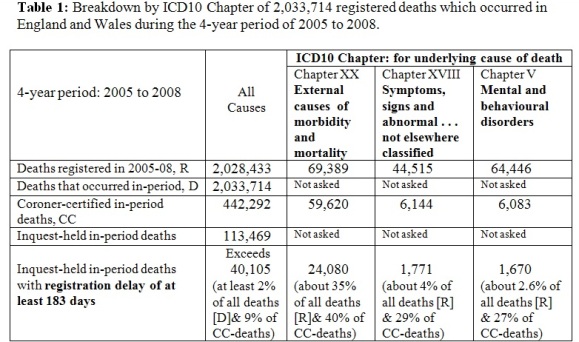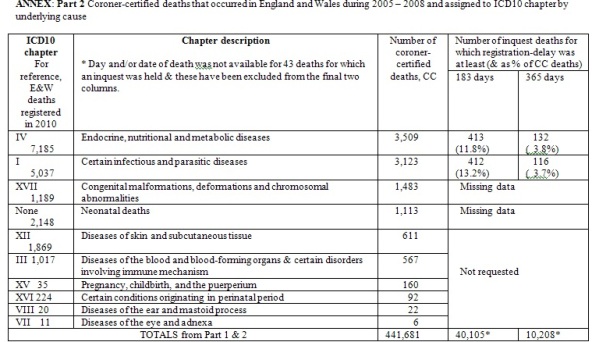Measuring the delays in coroner-certified deaths
Deaths certified by coroners in England are subject to registration delays, as Straight Statistics has pointed out on several occasions. But just how long are these delays, and how do they vary by cause of death?
A series of Parliamentary questions put in January 2012 enable us to provide answers. The first established how many of the 2,033,714 deaths in England and Wales which occurred during the 4-year period of 2005 to 2008 were certified by coroners.
The answer is: there were 442,292 coroner-certified deaths (22 per cent of all deaths)in this period, and for 113,469 of them - just over a quarter - an inquest was held, see Table 1.
Delay in death-registration exceeded six months for about 1 in 11 of all coroner-certified deaths (that is for over 40,000 deaths in the four years), see Table 1, and exceeded 12 months for a quarter of these (10,208 out of 40,105).
We did not ask about registration-delays exceeding six months in the nearly 329,000 deaths certified by a coroner but not the subject of an inquest, which we assumed would be few. However, perhaps the Office for National Statistics (ONS) should be asked to confirm that.

Instead, our subsequent questions homed-in on classifying the 442,292 coroner-certified deaths by their underlying cause to one of the 20 chapters into which the International Classification of Diseases (10th edition: ICD10) groups cause of death. See ANNEX for details. (For technical reasons, this has had to be divided in two in order to make it possible to post it on the website.)
For each ICD10 chapter which had accounted for at least 1,000 coroner-certified deaths in 2005-2008, we wanted more information, to enable us to identify those chapters that had been most vulnerable to late registration of deaths. We therefore asked for the deaths included in each chapter, how many of those subject to inquest had had a registration delay of at least 183 days between date of death and date of death-registration? And for how many was the registration-delay longer than one year?
The three most vulnerable ICD10 chapters are identified in Table 1. Over 40,000 deaths in England and Wales during 2005 to 2008 were subject to registration delays of at least six months, but they represented only around 2 per cent of the roughly 2 million deaths in the period. However, there were some chapters with much greater delays. Most notably for Chapter XX: external causes of morbidity and mortality, around 35 per cent of deaths were subject to registration delays of at least 6-months. In the protracted interim between date of death and date of death-registration, nobody was officially aware that more than 24,000 people had died whose death was eventually coded as due to external causes.
Next, unsurprisingly, come deaths classified to ‘Symptoms, signs and abnormal clinical and laboratory findings, not elsewhere classified’ with about one in seven of these being coroner-certified. In this ICD10 Chapter (XVIII), the registration delay is at least six months for over a quarter of the coroner-certified deaths.
Third is ICD10 Chapter V: Mental and behavioural disorders. A generally lower percentage of all chapter V’s deaths is coroner-certified than applies for chapter XVIII deaths but, for those which are coroner-certified, the registration delay is at least six months for more than a quarter of them.
Taken together, Chapters XVIII and V accounted for around 109,000 registered deaths which occurred during 2005-08. Registration-delay was at least 6m six months for 3 per cent of these deaths. And so, perhaps there is not too much to worry about, except that we also wanted to display, for the short-list ICD10 codes that the ONS conventionally uses (its chosen verses), the same sort of information as given in Table 1 and ANNEX for ICD10 chapters. We had restricted effort on ONS’s part by requesting data for only those short-listed codes (verses) which accounted for at least 500 coroner-certified deaths in 2005-2008.
We were surprised that ONS had not already done the analysis already. We have, after all, demonstrated the serious confounding that registration-delays caused in properly monitoring time-trends in cocaine-related deaths in the aftermath of mephedrone (see previous Straight Statistics articles here and here. And we have documented that only 70 per cent of heroin-related deaths which occurred during 2005 to 2008 were registered in the same or the subsequent two quarters as death had occurred in.
Instead, ONS claimed disproportionate time would be needed to program the requisite coding to discover which of its own short-list of ICD10 code-groupings (verses) were most vulnerable to confounding of time-trends by reason of lengthy registration-delays of at least six months.
This seems oddly out-of-tune at a time when the UK Statistics Authority is actively consulting on mortality statistics. We queried ONS’s stance and were given the following welcome assurance that chapter and verse will be available in summer 2102, and will be published alongside ONS’ annual Death Registrations publication in the summer.
It was more than 18 months ago that the Royal Statistical Society, in its written evidence to the House of Commons Science and Technology Select Committee’s Inquiry into Scientific Advice in Emergencies, called for an end to delays in registering deaths in England and Wales* – if necessary, by legislation - so that (as in Scotland) all deaths would have to be registered within 8 days of death having been ascertained. And a year has elapsed since the Chief Medical Officer’s H1N1 Statistical Legacy Group made a similar recommendation.
Quite apart from the statistical issues posed by registration-delays, which all agree need to be addressed, the failure in England and Wales promptly to register deaths is a security risk.
* Cause of death would be added later for inquest-deaths. But, ONS would at least know how many deaths there had been for whom information on cause was lacking; and ONS could properly compute waiting-times to inquest-verdict and adjust calendar-year estimates.


Conflicts of interest: SMB drafted the Royal Statistical Society’s submission to the Science and Technology Select Committee’s inquiry on Scientific Advice in Emergencies, and served on CMO’s H1N1 Statistical Legacy Group (chair: Professor John Newton).



